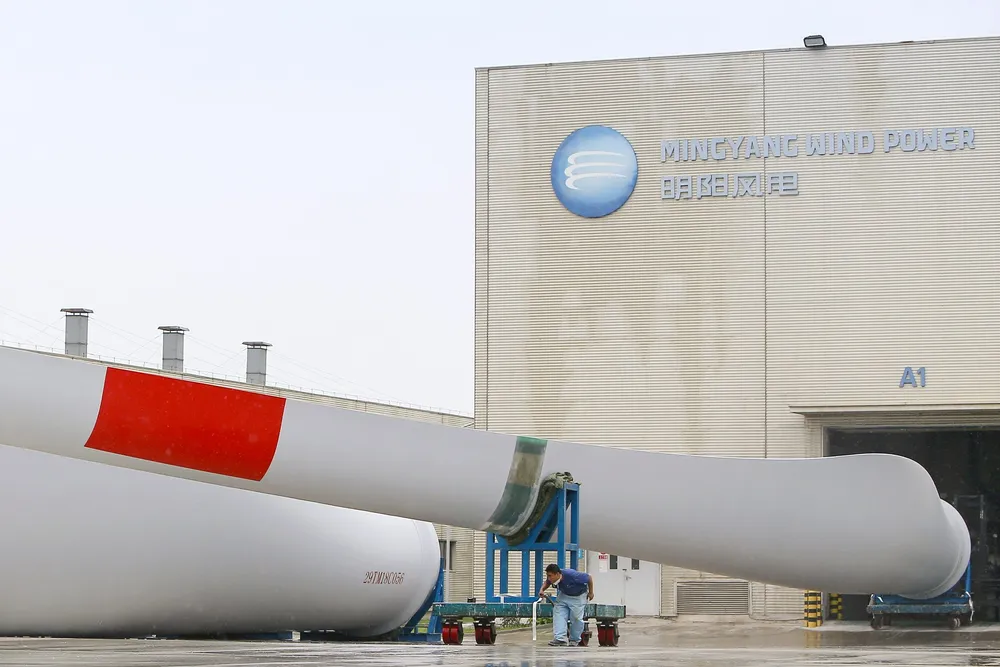'Why not?' | What Western wind giants say about using Chinese turbines
Several of Europe’s leading offshore wind farm developers have signalled cautious openness to the Chinese

With Mingyang confirming plans to open a UK offshore wind turbine factory, the attitude of Western developers to buying Chinese machines has taken on renewed importance. So what have giants like RWE, Iberdrola and Orsted said on the topic? We take a look.
Mingyang revealed details of a three-phase project that will involve investing up to £1.5bn ($2bn) in a factory for offshore and floating offshore projects for the UK and for export.
This plan, it must be stressed, remains subject to UK government approval. But if it does go ahead, the willingness of Western wind developers to buy Chinese machinery will be under more scrutiny than ever.
Cash-strapped developers, however, have different concerns – most namely their bottom lines in a squeezed offshore wind market.
Deepak Chinnapa, director at renewables consultancy Brinckmann Group, said that Western developers do “entertain” Chinese wind suppliers – not least so they can “negotiate on price” with Western turbine makers.
Chinese onshore wind turbines are already “used extensively” in another Western market, Australia, he notes. However, there is “more scrutiny” for offshore projects around certification and compliance.
So what have Western offshore wind developers said themselves on the matter? For the most part, they have remained tight-lipped around their attitude to Chinese turbines and a handful of the biggest names did not respond to a request to comment on Mingyang's factory plan.
But occasionally their top managers have spoken out about the prospect of using Chinese turbines over the years. Below, we round up what a clutch of the biggest names in the Western market have said about the issue.
Orsted: ‘We reject nothing’
However, it is not just a matter of cost, he cautioned, adding that technology, quality and commercial factors are all considerations – as well as any regulatory risks.
“We keep an open mind,” said Nipper. “We reject absolutely nothing in this supply chain.”
Nipper added that Orsted has “obviously followed with interest the developments that we have seen, both in Italy and in Germany,” in a seeming reference to agreements Mingyang had struck to supply offshore wind farms in both countries.
RWE: ‘Risk of delaying wind power rollout without Chinese’
German power giant RWE has given somewhat mixed signals about its openness to using Chinese machines.
Utermöhlen cited China’s leadership in offshore wind deployment as a “compelling reason” for him to visit and see what the country’s suppliers “can offer”.
Of course, if Mingyang builds a UK factory, the turbines won’t have to come from China.
Iberdrola: ‘We must engage with all suppliers’
Garcia said Iberdrola must “engage with all [turbine suppliers] because it is a global market.”
Indeed, Garcia said Iberdrola was in talks over “small agreements with some Chinese turbine suppliers” for offshore machines – although it appears those talks never materialised in concrete deals.
"I think we are satisfied with our existing, traditional suppliers like Siemens Gamesa, Vestas etc,” he said. “We have been working together for more than 20 years.”
Statkraft: ‘Chinese maturing rapidly’
This would be conditional on Chinese suppliers meeting “very high” company standards, he said. “That starts with safety and then follows up with sustainability, and then we move on to technical and commercial aspects as well."
“But Chinese manufacturers are maturing very rapidly on a lot of these aspects, so there's no reason why they couldn't potentially get up to the high standards that we require over time.”
EnBW: ‘A future possibility’
"In the future, it would be a theoretical possibility to deal with Chinese manufacturers here. Yes, of course we have to do that, because it also has an economic component... However, this is not an issue for us at the moment.”
Luxcara: ‘A struggle without China’
Hamburg-based asset manager Luxcara entered into an agreement last year to use Mingyang turbines for an offshore wind project in the German North Sea.
“Without China, in supply and sub-supply, it would be very difficult to meet the build out targets in Europe.”
(Copyright)